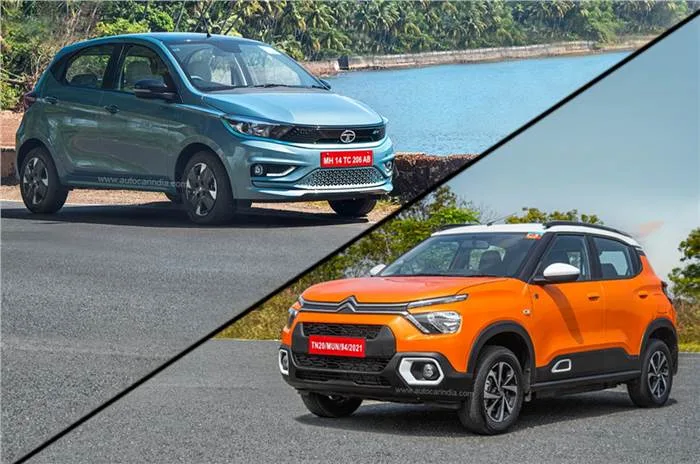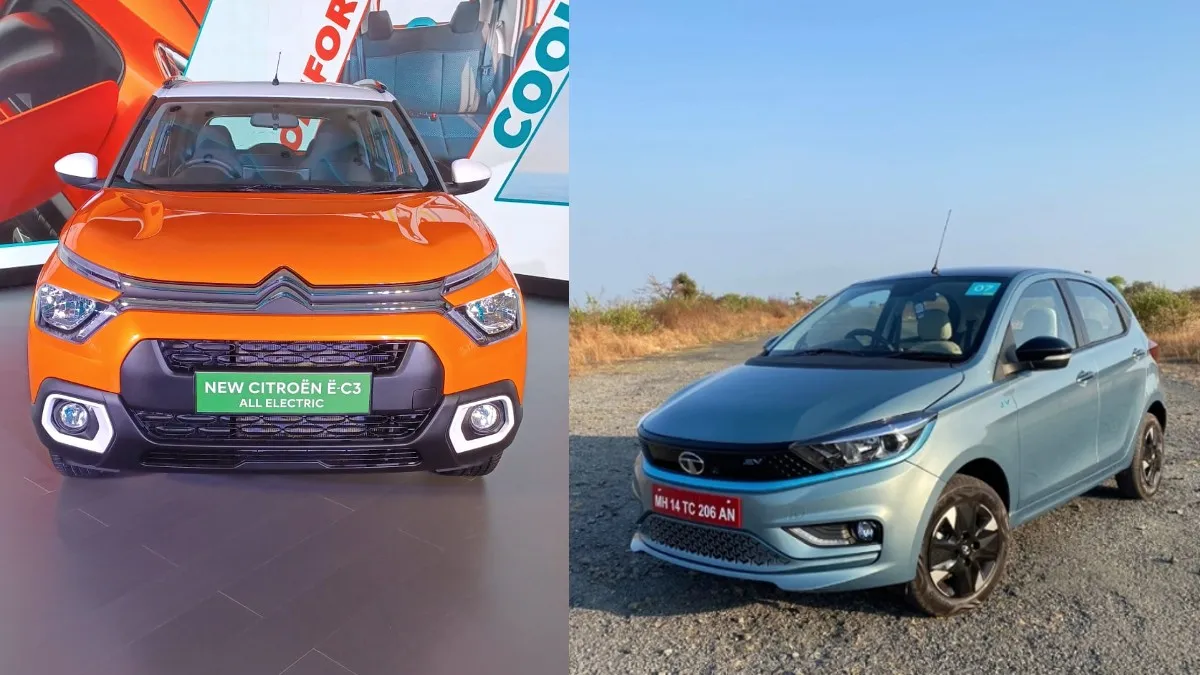In India’s rapidly evolving automotive landscape, electric vehicles are gaining momentum, particularly in the affordable segment. The Tata Tiago EV and Citroen eC3 stand at the forefront of this electric revolution, offering Indian consumers accessible options to go emission-free. Let’s dive into how these compact electric hatchbacks measure up against each other.
Contents
Electric Car Comparison India: Tata Tiago EV vs Citroen eC3 Face-Off

Design and Aesthetics
The Tata Tiago EV maintains the familiar silhouette of its ICE counterpart with subtle EV-specific enhancements, including blue accents and closed-off front grille that signal its electric credentials. At 3,765mm long and 1,677mm wide, it’s the more compact option, making it ideal for navigating congested urban environments.
The Citroen eC3, measuring 3,981mm in length and 1,733mm in width, brings distinctive French styling to the table. Its quirky design elements—including the signature Citroen chevron logo, unique light signatures, and colorful customization options—give it a standout personality on Indian roads.
Performance Metrics
The Tiago EV offers two battery options: a 19.2kWh pack delivering 250km range and a larger 24kWh version extending range to 315km. Its electric motor produces 74bhp and 114Nm of torque, propelling the car from 0-60kmph in 5.7 seconds. Multiple drive modes (City and Sport) and four levels of regenerative braking add versatility to the driving experience.
Citroen’s eC3 houses a single 29.2kWh battery pack claiming a 320km range. Its electric motor generates 76bhp and 143Nm of torque, with similar acceleration figures. The eC3’s higher torque output translates to better pulling power, especially noticeable when climbing inclines or executing overtaking maneuvers.
Features and Technology
Both contenders come equipped with modern tech amenities. The Tiago EV features a 7-inch touchscreen infotainment system with Android Auto and Apple CarPlay, automatic climate control, connected car technology with 35+ features, and a digital instrument cluster.
The eC3 counters with a 10-inch touchscreen supporting wireless smartphone integration, a digital driver display, and MyeCitroen app connectivity for remote vehicle monitoring. Its unique suspension setup with Progressive Hydraulic Cushions delivers superior ride comfort, a signature Citroen characteristic.
Pricing and Value Proposition
In the affordable electric cars India segment, pricing plays a crucial role:
| Aspect | Tata Tiago EV | Citroen eC3 |
|---|---|---|
| Starting Price | ₹8.69 Lakh | ₹11.50 Lakh |
| Top Variant | ₹11.99 Lakh | ₹12.43 Lakh |
| Battery Warranty | 8 years/160,000 km | 7 years/140,000 km |
The Tiago EV’s lower entry price makes it more accessible, while the eC3 justifies its premium with a larger battery and distinctive styling.
Practicality Considerations
The Tiago EV offers 240 liters of boot space compared to the eC3’s more generous 315 liters. The eC3 also boasts a longer wheelbase (2,540mm vs 2,400mm), translating to superior rear-seat legroom—an important factor for family buyers.
For charging infrastructure, Tata holds an advantage with its established network of over 3,000 charging points across India, complemented by home-charging solutions. Citroen is actively expanding its charging network but currently lags behind Tata’s established ecosystem.
Verdict: Which EV Takes the Crown?
The Tata Tiago EV emerges as the value champion with its lower entry price, established service network, and multiple battery options catering to different budget constraints. Its compact dimensions make it the perfect city runabout for first-time EV buyers.
The Citroen eC3 appeals to those seeking distinctiveness and comfort. Its larger dimensions, superior boot space, and unique styling make it attractive for buyers prioritizing practicality and French flair over outright affordability.
Your choice ultimately hinges on personal priorities—whether you value the reassurance of Tata’s extensive service network and lower starting price, or prefer Citroen’s distinctive styling, slightly higher range, and more spacious interiors.
As India accelerates toward an electric future, both these hatchbacks represent compelling options that bring zero-emission mobility within reach of the average Indian car buyer.

